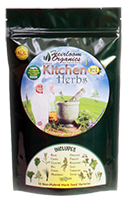 Contributed By: Elizabeth Trementozzi Krause
Contributed By: Elizabeth Trementozzi Krause
SimpleItalianCooking.com
Storing herbs to last through the fall and winter months.
Knowing what to do with an overabundance of unused herbs is a dilemma many of us encounter. Dealing with an extra supply of herbs on our hands does not only occur as we begin to hang up our gardening hat towards the end of the season. Consider the times we need fresh herbs for a garnish or special recipe during the off season months. We visit the grocery store and buy a fresh bunch of parsley or a few sprigs of thyme; yet we still end up with more herbs than the recipe calls for. There is no need to waste the unused herbs; instead with a little effort your herbs can be easily stored away for a later date.
Not all Herbs are Equal
Comparing one herb to another can be the equivalent of comparing apples to oranges. Not all herbs are the same, nor should they be stored the same either. Herbs can be categorized as high or low moisture content herbs. Depending on this classification can determine which method of storage is best suited for each herb.
High moisture herbs naturally contain a higher level of moisture content. Such examples are basil, cilantro, oregano, parsley, mint and sage. These herbs are suitable for freezing or drying, although freezing is preferred. Low moisture herbs naturally contain a lower level of moisture content. Examples of low moisture herbs are bay, dill, fennel, sage, savory, and thyme.
Freezing Herbs
As described above, the freezing method is best for herbs which contain high moisture content. There are two popular ways to freeze herbs. The first option is using ice cube trays and the second is using a flat surface such as a cookie sheet.
Ice cube trays: Naturally, you will need ice cube trays for this method. Do not worry if you do not already use ice trays for ice, you will want your own separate trays for the herbs to prevent your trays from absorbing any of the herbal flavors.
Simple take your herbs and make sure they are clean, free of dirt and any insects. You can choose to chop the herbs or keep them whole. Next, place them inside each compartment in the tray. Try to keep the filling consistent, such as putting 3 basil leaves in each cube so when you need them for later you will know how many cubes to use. Fill each compartment half way with water and put in the freezer until the cubes are mostly frozen. Fill the remainder of the cubes with water thereby fully encasing any basil (or other herb) which may have floated to the top of the water. Place back in the freezer and when completely frozen transfer the cubes from the trays into sealable freezer bags. Label and date each bag with all the necessary information such as herb name, date frozen, and quantity in each cube.
Flat surface freezing: This method is fairly straight forward and requires less steps, but just as practical. First take your herbs and make sure they are clean without any dirt or insects. Pat them dry with some paper towels. Next, spread them out on a cookie sheet or other flat surface, making sure not to overlap any of the leaves. If the herbs are overlapping, they will stick together when frozen and cannot be separated. Place the cookie sheet in the freezer. Once the herbs have frozen, place them in small freezer bags. Label and date the bags so you will not forget what each bag contains.
In the case of herbs such as rosemary, dill and thyme, it is best to leave these herbs with their stems intact and place in freezer bags with 3-4 sprigs per bag.
Drying Herbs
Drying herbs can be used for all types of herbs, unlike freezing herbs which is only suitable for certain types. Many people prefer to dry their herbs and keep them in jars which can be placed in a pantry or cupboard. There are two different methods for drying herbs, air drying is the first method and the second method is using a dehydrator.
Air drying: This is the most economical method as it does not cost a dime. There are two ways to air dry herbs. The first method is to spread the cleaned (and patted dry) leaves on an aerated surface such as a wire screen. This allows proper air flow, it is recommended to turn the leaves over frequently to ensure even drying. It is best to do this process indoors away from intense heat and light which would cause the herbs to lose greater amounts of flavor.
The second air drying method is to tie a few branches of the herbs together and hang them upside down inside a brown paper bag. Place the bag in a cool and dry location leaving the leaves undisturbed for approximately 14 days. At that point check the leaves once a week until they have fully dried.
Dehydrator: Dehydrators can be used for drying many foods, not just herbs. Because there are such a variety of dehydrators available on the market, it is best to read the instructions manual to know what settings to use for drying your herbs. The dehydrator operates in a manner which will work just fast enough to prevent mold from occurring, but also slow enough to cause minimal loss of flavorful oils. This method is preferred for herbs which contain high moisture content.
Once your herbs are dried, you can store them whole (such as bay leaves) or crumble the herbs (such as oregano) before placing them in an airtight container such as a glass jar.
The process of storing herbs provides significant benefits as you encounter the fall and winter months following every growing season. The simple joy of serving bowls of pasta topped with fresh parsley or oregano flavored Italian sauce during the middle of winter is an experience many people unfortunately do not encounter. However, it is safe to conclude, whether a new beginner or a seasoned gardener or chef, properly storing herbs is a skill easily learned and from which the benefits are always truly gratifying.
This article was contributed by Elizabeth Trementozzi Krause, an Italian home cook whose passion lies with creating simple Italian recipes. One of her easiest and most enjoyed Italian chicken recipes is her breaded chicken breasts with fresh chopped parsley. She and her husband reside in Culpeper, Virginia and like to top off their meals with a latte made from their Italian stovetop espresso maker. She enjoys gardening and sharing her experiences with others.


